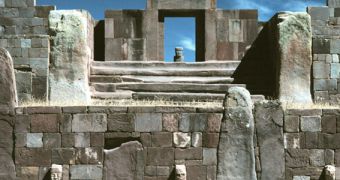Tiwanaku were the most important precursors of the mighty Inca Empire. But as they left no written records, many details about their culture remain unknown.
Today only three Tiwanaku buildings still stand: the Akapana fortress-pyramid, the temple Kalasaya and the Palace of the Ten Doors. Now, archaeologists have discovered the 1,300-year-old skeleton of a high hierarchy character, ruler or priest, of this ancient civilization together with valuable jewels inside the Akapana pyramid, in Western Bolivia, which was intensively looted over the centuries.
"The bones are in very good condition and belong to either a ruler or a priest," said the discoverer Roger Angel Cossio, a Bolivian archaeologist.
"The tomb -- containing a diadem and fist-sized carved pendant of solid gold -- survived centuries of looting by Spanish invaders and unscrupulous raiders who depleted Tiwanaku of many precious treasures. After so much looting... miraculously this has stayed to tell us the history," Cossio said.
"It's a complete body... next to it are jewels, offerings and a llama," he said.
The llama was in the Andean cultures a status symbol and the researchers believe the animal could have been sacrificed to feed the deceased during the journey to the afterlife. The skeleton was detected in a niche inside the pyramid.
The Akapana pyramid is 15 m high and was constructed around 1200 BC, being one of the largest buildings made by the indigenous civilizations in South America.
"At its peak, the city of Tiwanaku stretched over 1,480 acres and had a population of over 100,000," explained chief archaeologist Javier Escalante.
The Tiwanaku Empire covered western Bolivia, southern Peru and northern Chile from around 200 BC to AD 1000. The remains have not been carbon dated yet, but the researchers estimated they were buried 1,300 years ago, towards the end of this civilization.
"Not just anyone would be buried under the Akapana pyramid" said Cossio, alluding to the high ranking of the deceased.
The ancient people carried 200 tons heavy stone blocks from 40 km away without the aid of the wheel (the pre-Columbian societies did not know the wheel) while in the 1900s workers used the stone from the base of the pyramid to construct a rail line between the neighboring town of Guaqui and La Paz.

 14 DAY TRIAL //
14 DAY TRIAL //